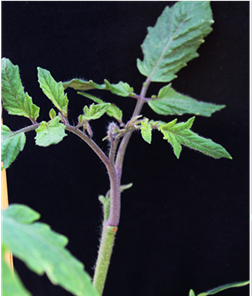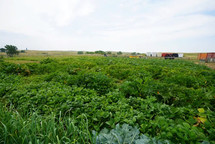
Yes, Allergy Seasons Are Getting Worse. Blame Climate Change.
If you live with seasonal allergies and feel like the pollen seasons feel longer and longer every year, you may be right. New research shows that pollen seasons start 20 days earlier, are 10 days longer and feature 21% more pollen than in 1990 — meaning more days of itchy, sneezy, drippy misery. Led by William Anderegg of the University of Utah School of Biological Sciences, the researchers found that human-caused climate change played a significant role in pollen season lengthening and a partial role in pollen amount increasing. Their research, funded in part by NIFA, is published in the Proceedings of the National Academy of Sciences.
Pollen is visible on a Colorado blue columbine, courtesy of Getty Images.
|
Nanotechnology in Agriculture and Food Systems
 Nanotechnology graphic, courtesy of the Multistate Research Fund Impacts Program.
With support from NIFA, researchers at Land-grant Universities are working together to develop nanotechnology that can be used to detect pathogens, develop vaccines, target drug delivery, create antimicrobial packaging, purify water, combat antimicrobial resistance and more. Education facilitates the development and use of nanotechnology, and partnerships with industry are making these technologies broadly available.

Planting for the Future
A name like Junior Master Gardeners evokes images of planting seeds with a hope for a bountiful harvest. But the bountiful harvest that Cooperative Extension educators want to achieve isn’t vegetables or fruits. Rather, the NIFA-supported Junior Master Gardener® (JMG ®) program works to grow an even more important resource. “Our mission is to grow good young people,” said JMG National Coordinator Lisa Whittlesey. “We want to ignite a passion for learning, for success and for giving back to the community. We hope they learn about horticulture, but our goal is to foster positive youth development.”
Plant Something Day graphic, courtesy of NIFA.
|

World Bee Day: May 20
There are over 20,000 known bee species in the world, and 4,000 of them are native to the United States, according to the U.S. Geological Survey. They range from the tiny (2 mm) and solitary Perdita minima, known as the world’s smallest bee, to kumquat-sized species of carpenter bees. Native bees are the primary insect pollinator of agricultural plants in most of the country. On World Bee Day, learn how Land-grant Universities are supporting the nation’s bee population with funding from NIFA.
World Bee Day graphic, courtesy of NIFA.
|

University of Hawaiʻi Maui College Expands Aquaponics Training
At the University of Hawaiʻi Maui College, educators have launched — with funding from NIFA — the Adapting Precision Farming Technologies for Sustainable Aquaponics Systems in Hawaiʻi project at the campus’ WaiPono Farm aquaponics and hydroponics greenhouse. The project focuses on expanding workforce training using precision agriculture technologies in aquaponics systems. “This project will address key community training needs relevant for local agriculture,” said Chancellor Lui Hokoana. “The potential impacts of the project include advancing knowledge in the application of precision agriculture technologies in aquaponics production systems and developing sustainable food systems in Hawaiʻi for food security and community resiliency.”
Asian American, Native Hawaiian and Pacific Islander graphic, courtesy of USDA.
|

National Wine Day: Growing Great Grapes
Grapes are the highest-value fruit crop grown in the U.S. Over 70% of the grapes grown are used in wine. As wine grape production expands to new areas in the U.S., growers need grape varieties suited to their growing conditions, which can differ environmentally and economically from traditional regions. Growers also need varieties that are more resistant to common pests and diseases. Wine producers are interested in new varieties they can use to create new wines and expand sales. To find the best grapes for U.S. growers and wine producers, Land-grant University researchers supported by NIFA are testing the performance and resulting wine quality of different grape varieties, including traditional, lesser-known and new varieties.
National Wine Day graphic, courtesy of NIFA.
|

Celebrating 30 Years of SNAP-Ed
This month, the Supplemental Nutrition Assistance Program – Education (SNAP-Ed) celebrates 30 years of providing evidence-based nutrition education and obesity prevention interventions and projects for those eligible for SNAP benefits. Through complementary direct education, multilevel interventions, and community and public health approaches to improve nutritional health of historically underserved populations, this federally funded grant program has impacted lives for three decades.
Celebrating 30 Years of SNAP-Ed graphic, courtesy of USDA.
|

USDA Invests $770 Million to Expand Market Opportunities for Rural Businesses and People in 36 States and Puerto Rico
Agriculture Secretary Tom Vilsack has announced that the Department is investing $770 million to help create new and better market opportunities for rural businesses and people in 36 states and Puerto Rico. The investments include $640 million for 122 projects to help people living in socially vulnerable communities.
USDA graphic symbol.
|
The Personal Approach to Address Rural Mental Health Issues and Stigmas
Awareness efforts are making headway to reduce and remove stigmas associated with mental health issues in rural America, making such matters easier to discuss. This is allowing more people to reach out to those who may need help. Rod Bain looks at efforts in increasing rural mental health awareness and examples of how an individual can help someone in need in this edition of Agriculture USA.

Biden-Harris Administration Launches Affordable Connectivity Program
As part of the Bipartisan Infrastructure Law, President Biden and Vice President Harris worked with Democrats, Republicans, and Independents to create the Affordable Connectivity Program (ACP), which provides eligible households $30 per month off their internet bills. To deliver maximum cost savings to families, the Biden-Harris Administration has secured commitments from 20 leading internet providers to offer ACP-eligible households a high-speed internet plan for no more than $30 per month. Eligible families who pair their ACP benefit with one of these plans can receive high-speed internet at no cost.
Affordable Connectivity Program graphic, courtesy of the White House.
|

Researcher Finds Fighting White-Nose Syndrome in Bats Benefits Agriculture
For years, bats have gotten a bad rap as the creepy creatures lurking in the dark. But for just as long, agricultural producers have known that the winged wonder is actually the hero of the story, not the villain. Now a plague is decimating bat colonies. The culprit: white-nose syndrome. And it’s costing U.S. agriculture up to $495 million each year, according to new Colorado State University and University of Illinois Urbana-Champaign research supported by NIFA.
“When bats get this disease, it’s deadly to them, and it’s highly contagious,” said Colorado State University Associate Professor Dale Manning. “Lost bat populations have harmful ripple effects on food and agriculture,” said University of Illinois Urbana-Champaign Professor Amy Ando. “Crop yields fall- and input costs rise as farmers try to compensate for the services bats usually provide. That drives down the value of farmland and the number of acres planted, and the supply shock probably also hurts consumers as ag production becomes more costly.”
As seen in these little brown bats, the most commonly observed symptom of white-nose syndrome is the white fungal growth on the muzzle.Photo courtesy of Nancy Heaslip/New York State Department of Environmental Conservation.
|

UF Scientists May Have Found a Way to More Efficiently Apply Genome Editing to Plant Breeding
New NIFA-funded research led by a University of Florida (UF) scientist shows a development regulator can help plants grow. In the bigger picture, the study’s results also may help genome editing and, as a result, plant breeding. Development regulators are genes that regulate plant development and growth. UF scientists have discovered that one such gene can help deliver DNA into a plant to promote shoot growth form either a stem of a whole plant or young leaves cultured in a petri dish.
A red tomato shoot grown from a green stem of tomato plants.
Photo courtesy of Alfred Huo, UF/IFAS.
|

4-H Tech Changemaker Program
According to the Federal Communications Commission, more than 24 million people in the U.S. lack high-speed internet access. Even more, don’t have the skills needed to take full advantage of online resources. Combining those two things creates a digital divide that impacts future opportunities for young people and adults. According to Kristen Wells-Lewis, Prairie View A&M University’s Cooperative Extension Program’s Dallas County 4-H Youth Development Extension Agent, that’s where we come in. By we, she means Panther Tech, a group of 4-H Tech Changemaker ambassadors at Duncanville High School in Dallas County that aims to close the digital divide and provide #Opportunity4All people in their community.
A student participates in Panther Tech. Photo courtesy of Prairie View A&M University.
|

May 24-26: Making Climate-Smart Agriculture Work
The NIFA-funded Agricultural Model Intercomparison and Improvement Project is hosting a national conference May 24-26 on Making Climate-Smart Agriculture Work. The focus of the virtual conference is to share information and best practices regarding integrating science, modeling and economics to help farmers, ranchers and foresters mitigate and adapt to the challenges of climate change.
Webinar graphic, courtesy of NIFA.
May 26: Gus Schumacher Nutrition Incentive Program (GusNIP) Produce Prescription RFA Webinar
NIFA will host a webinar Thursday, May 26 at 6 p.m. EDT to discuss the Gus Schumacher Nutrition Incentive Program (GusNIP) Produce Prescription RFA. GusNIP brings together stakeholders from various parts of the food and healthcare systems. The competitive grant program portfolio includes nutrition incentive projects, produce prescription projects, and training, technical assistance, evaluation and information centers which provide support services to both nutrition incentive and produce prescription projects. Produce prescription projects aim to increase procurement and consumption of fruits and vegetables, reduce individual and household food insecurity, and reduce healthcare usage and associated costs.
June 3: Youth Innovators Empowering Agriculture Across America (YEA) RFA Webinar
NIFA will host a webinar Friday, June 3 at 2:30 p.m. EDT to discuss the Special Topics: Youth Innovators Empowering Agriculture Across America (YEA) (A7703) Program Area Priority, which has two new budget requests: Youth Innovators Empowering Agriculture Across America (YEA) project budgets must not exceed $7,850,000 total per project for project periods of four or five years (60 months) and Youth Innovators Empowering Agriculture Across America Coordination Network (YEA-CN) project budgets must not exceed $5,000,000 total per project for project periods of four or five years (60 months). The YEA program seeks projects supporting one or more of the six Agriculture and Food Research Initiative Farm Bill priorities, as well as one or more of the USDA priorities of addressing climate change via climate-smart agriculture and forestry; advancing racial justice, equity and opportunity; creating more and better market opportunities; tackling food and nutrition insecurity; and promoting workforce development. The outcome of the YEA program will be a reimagined and enhanced system of Positive Youth Development outreach.
June 6: Children, Youth, and Families At-Risk Professional Development and Technical Assistance (CYFAR PDTA) RFA Orientation
On Monday, June 6, NIFA will host two webinars for prospective applicants to learn more about the Children, Youth, and Families At-Risk Professional Development and Technical Assistance (CYFAR PDTA) Request for Applications. The times of the webinars are 3:30 and 6 p.m. EDT.
June 7: NIFA Nutrition Security Webinar Series - an App and a Carrot: An Overview of the Evolution and Impacts of VeggieBook
On Tuesday, June 7, at 3:30 p.m. EDT, Drs. Peter Clarke and Susan Evans will share the story of their smartphone app, called VeggieBook, which is designed for food pantry clients. The app helps household cooks prepare tasty servings and snacks using vegetables. Drs. Evans and Clarke’s work was supported in part by NIFA. In the NIFA Nutrition Security Webinar, the presenters will explain origins of their app, the app’s content and how it works, evidence about the app’s effectiveness, and lessons learned from disseminating the app.
June 14: Rapid Response to Extreme Weather Events Across Food and Agriculture Systems Live FAQ Session
NIFA will host a Live FAQ Session Tuesday, June 14 at 3 p.m. EDT to discuss the AFRI Rapid Response to Extreme Weather Events Across Food and Agricultural Systems (A1712) Program Area Priority. This program area priority is designed to rapidly identify and implement strategies to protect the nation’s food and agricultural supply chains and the people who support them during and after extreme weather events. We invite interested applicants to learn more about this program area priority and to meet our team during a live FAQ event.
|
NIFA Invests in Small Business Innovation Research Program: Animal Production and Protection
NIFA recently awarded eight grants under the Animal Production and Protection topic area of the USDA’s Small Business Innovation Research (SBIR) program. SBIR is a highly competitive program that encourages domestic small businesses to improve both productivity and efficiency of food animals. The Animal Production and Protection topic area aims to develop innovative, marketable technologies to help agricultural animal producers improve production efficiency, prevent diseases and outbreaks, conserve resources, and reduce costs of production.
NIFA Invests in Small Business Innovation Research Program: Conservation of Natural Resources
USDA's SBIR Program, administered by NIFA, recently awarded 10 grants to U.S. small businesses to increase the sustainability and profitability of farms and ranches. SBIR is a highly competitive program that encourages domestic small businesses to improve soil health, reduce soil erosion, improve water and air quality, improve nutrient management and conserve and use water more effectively. The awards will advance conservation and natural resources by creating technology and protecting essential resources while sustaining optimal agricultural productivity by enhancing air, soil- and water quality; developing irrigation techniques; reducing erosion and pollution caused by agriculture enterprises; and promoting these new technologies.
NIFA Invests in Small Business Innovation Research Program: Food Science and Nutrition
NIFA recently awarded eight grants under the Food Science and Nutrition area of the USDA’s SBIR program. SBIR is a highly competitive program that encourages domestic small businesses to improve the production of useful new food products, processes, materials, and systems that reduce foodborne illness and carbon footprints, improve nutrition and health, enhance the nutritional quality and value of foods and/or bridge socioeconomic gaps in access to healthy foods/sustainable, resilient food practices. The awards will develop products and processes from new knowledge; improve methods of processing and packaging for better quality and nutritional value; and promote programs and products that increase consumption and understanding of healthy foods while reducing childhood obesity.
NIFA Invests in Small Business Innovation Research Program: Aquaculture
The USDA SBIR Program, administered by NIFA, recently awarded five grants to U.S. small businesses to promote and improve aquaculture. SBIR is a highly competitive program that encourages domestic small businesses to improve production efficiency and increased competitiveness of private sector, commercial aquaculture in the U.S. These awards will improve private sector production and competitiveness by increasing reproductive efficiency and genetic improvement in fish and shellfish; enhancing animal health, food safety, production efficiency and cost-effective production of alternative proteins; and reducing water usage.
NIFA Invests in Small Business Innovation Research Program: Small and Mid-Size Farms
The USDA SBIR Program, administered by NIFA, recently awarded seven grants to U.S. small businesses to promote and improve the sustainability and profitability of small and mid-size farms and ranches. SBIR is a highly competitive program that encourages domestic small businesses to improve viability and sustainability of small farms and the stewardship of our biological and natural resources. These awards will increase sustainability and profitability of farms and ranches through newly developed plant, animal, organic and natural products; enhanced farm safety; increased operation efficiency; and conservation of natural resources.

The Green Sheet Farm Forum: Lakota Gardening Initiative Becomes Oasis in Multi-County Food Desert in South Dakota
If you live in one of the rural communities on the Pine Ridge Indian Reservation, you are likely not making daily grocery runs. Nearly the entirety of Pine Ridge is considered a "food desert." Lakota Food Sovereignty Coalition is the Oglala Lakota response to food insecurity. Formed in 2007, the community-centered group has been giving tribal members the tools to grow their own foods. The coalition is part of a broader gardening initiative, aided by NIFA and state universities, to help people on the Pine Ridge, Rosebud and Cheyenne River Reservations take health back into their own hands — an important role in maintaining tribal sovereignty.
Several vegetables ripen at the Thunder Valley Community Development Corporation’s community garden. Photo courtesy of Thunder Valley CDC.
|

Through NIFA funding, the Farm Stress Center works across 12 states to ensure agriculture producers have access to resources related to stress management and mental health.
|

Meet Adam Wilke
Adam serves as a national program leader in the Institute of Bioenergy, Climate Change, and Environment. “I am eager to apply my background in farming and training in social science to help advance the frontiers of agricultural research, education, and Extension to solve societal challenges.” – Adam
|
|